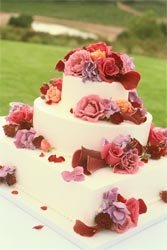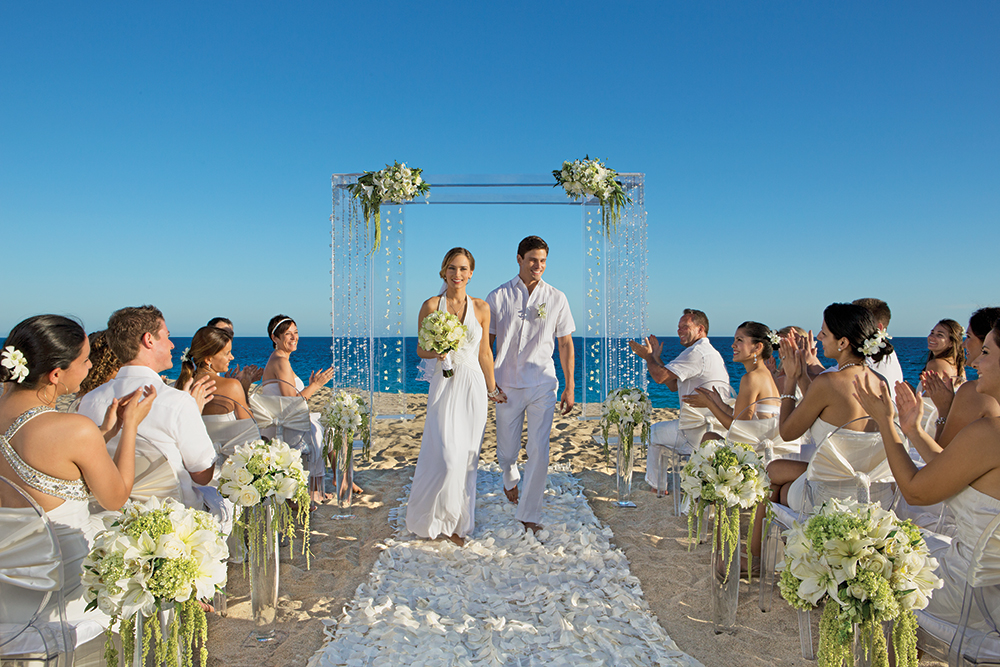Treat your guests to an unforgettable meal on your unforgettable day with our step-by-step guide.
By: Nicole Burnham Onsi
Dessert—Done Right
 |
Time was, the wedding cake was like a prop at the reception: You had to have one, but you didn't think too much about, or have much choice in, what it looked and tasted like. There it would be, a few tiers of frothy white with a ceramic couple teetering on top. And inside? Well, who cared? It wasn't there to be a delicious dessert.
Thankfully, that has changed. Today's bakers now turn out wedding cakes that are true works of art—and sweet pleasers that perfectly cap off a reception. Regula Onstad, owner of Regula's Specialty Cakes in Brooklyn, New York, says that the best way to find your dream baker is through word of mouth. Ask recent brides, of course, but also check with your florist, DJ or band—they're bound to have resources. If wedding-cake bakers appear at local bridal shows, be sure to visit their booths—they'll often have free samples on hand!
When you meet with a baker, ask her what types of cakes she specializes in. She may offer flavors or flavor combinations you might not have considered. She may also allow you to taste-test a few, often for a small charge. Ask to see an album of her past creations to get an idea of her decorating ability.
Onstad says that many brides have a good idea of what they want. "Either they'll like a picture of a cake I've done in the past, or they'll bring in pictures of cakes from wedding magazines." Be prepared: Even if you haven't seen a photograph of the exact cake you want, bring pictures in which some element—the icing color, the shape of the cake, the decoration—is something you'd want. "A good baker will work with that, and tell you what she can and can't do," says Onstad.
Think about how your cake will fit in at the reception location, as well as with the time of year and day; there's the obvious (certain icings, like whipped cream or buttercream, don't do well in warm weather at outdoor weddings), and the not-so-obvious (a lavishly decorated cake may look out of place at an informal location). You'll also want to make sure the cake coordinates with your flowers, your colors and the type of dinner you'll be serving. Finally, consider the time of year. Light, fruity cakes appeal in spring and summer, while in fall or winter you can serve a richer flavor of cake.
 |
To save money on your wedding cake, consider having a smaller, formal cake for the cutting ceremony, and a sheet cake of the same flavor for serving to guests. Beyond that, however, there are not many ways to cut corners on a wedding cake—inferior ingredients spoil the taste. "In the overall scheme of things, the wedding cake is not a big expense. You'll have an easier time cutting costs elsewhere," advises Onstad. (See our Cake Guide for more information.)
Of course, dessert doesn't have to be all about the wedding cake. Hasslocher notes that at weddings she's catered in Texas, Mexican wedding cookies or pralines are commonly served. "We've also done fresh fruit displays with various dipping sauces," she says. Many brides also opt for dessert bars, featuring eclairs, tartlets, cream puffs and truffles.
Other options: a crêpe bar, with fruit-filled creations flambéed in brandy, and dessert cheeses, served with crackers and fresh fruit. Coffee bars are also popular with guests. Think made-to-order latte or cappuccino served with chocolate sticks, help-yourself toppings like cinnamon or whipped cream, and a selection of light desserts. "Dessert should really be a highlight of the meal, not an afterthought," says Benning. "Be lighthearted, have fun with your choices, and your guests will enjoy themselves, too."




